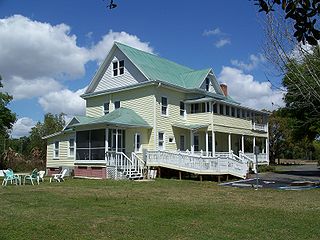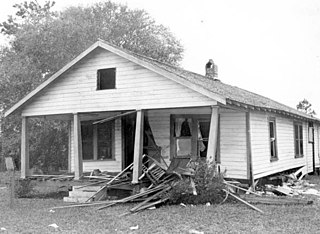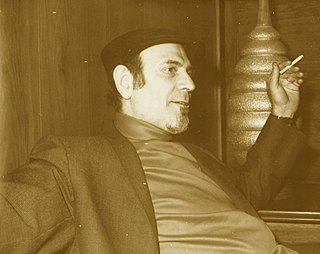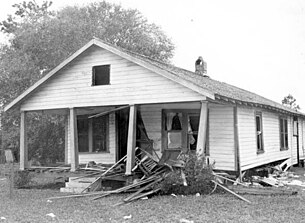
The Ku Klux Klan, commonly shortened to the KKK or the Klan, is an American white supremacist, right-wing terrorist, and hate group whose primary targets are African Americans, Jews, Latinos, Asian Americans, Native Americans, and Catholics, as well as immigrants, leftists, homosexuals, Muslims, atheists, and abortion providers.

Mims is a census-designated place (CDP) in Brevard County, Florida. The population was 7,058 at the 2010 United States Census.

Groveland is a city in Lake County, Florida, United States. The population was 8,729 at the 2010 census. Between 2000 and 2010, Groveland's population increased by 189%, making it the fastest growing place in Florida. However, its land area increased more than fivefold due to annexation. It is located at the intersection of State Road 19 and State Road 33/50.

Medgar Wiley Evers was an American civil rights activist and the NAACP's first field secretary in Mississippi, who was murdered by Byron De La Beckwith. Evers, a decorated U.S. Army combat veteran who had served in World War II, was engaged in efforts to overturn segregation at the University of Mississippi, end the segregation of public facilities, and expand opportunities for African Americans including the enforcement of voting rights.

The 16th Street Baptist Church bombing was a white supremacist terrorist bombing of the 16th Street Baptist Church in Birmingham, Alabama, on Sunday, September 15, 1963. Four members of a local Ku Klux Klan chapter planted 19 sticks of dynamite attached to a timing device beneath the steps located on the east side of the church.

Viola Fauver Liuzzo was an American civil rights activist. In March 1965, Liuzzo heeded the call of Martin Luther King Jr. and traveled from Detroit, Michigan, to Selma, Alabama, in the wake of the Bloody Sunday attempt at marching across the Edmund Pettus Bridge. Liuzzo participated in the successful Selma to Montgomery marches and helped with coordination and logistics. At the age of 39, while driving back from a trip shuttling fellow activists to the Montgomery airport, she was fatally hit by shots fired from a pursuing car containing Ku Klux Klan members Collie Wilkins, William Eaton, Eugene Thomas, and Gary Thomas Rowe, the last of whom was actually an undercover informant working for the Federal Bureau of Investigation (FBI). Although the State of Alabama was unable to secure a murder conviction, Wilkins, Eaton, and Thomas were charged in federal court with conspiracy to intimidate African Americans under the 1871 Ku Klux Klan Act, a Reconstruction civil rights statute. On December 3, the trio was found guilty by an all-white, all-male jury, and were sentenced to ten years in prison, a landmark in Southern legal history.
The Greensboro massacre was a deadly confrontation which occurred on November 3, 1979, in Greensboro, North Carolina, US, when members of the Ku Klux Klan and the American Nazi Party (ANP) shot and killed five participants in a "Death to the Klan" march which was organized by the Communist Workers Party (CWP). The people who were killed included four members of the CWP, who had originally come to Greensboro to support workers' rights activism among mostly black textile industry workers in the area. The Greensboro city police department had an informant within the KKK and ANP group who notified them that the Klan was prepared for armed violence.

Edgar Ray Killen was an American Ku Klux Klan organizer who planned and directed the murders of James Chaney, Andrew Goodman, and Michael Schwerner, three civil rights activists participating in the Freedom Summer of 1964. He was found guilty in state court of three counts of manslaughter on June 21, 2005, the forty-first anniversary of the crime, and sentenced to 60 years in prison. He appealed the verdict, but the sentence was upheld on April 12, 2007, by the Supreme Court of Mississippi. He died in prison on January 11, 2018, six days before his 93rd birthday.

The murders of Chaney, Goodman, and Schwerner, also known as the Freedom Summer murders, the Mississippi civil rights workers' murders, or the Mississippi Burning murders, refers to events in which three activists were abducted and murdered in the city of Philadelphia, Mississippi, in June 1964 during the Civil Rights Movement. The victims were James Chaney from Meridian, Mississippi, and Andrew Goodman and Michael Schwerner from New York City. All three were associated with the Council of Federated Organizations (COFO) and its member organization, the Congress of Racial Equality (CORE). They had been working with the Freedom Summer campaign by attempting to register African Americans in Mississippi to vote. Since 1890 and through the turn of the century, southern states had systematically disenfranchised most black voters by discrimination in voter registration and voting.

Harry Tyson Moore was an African-American educator, a pioneer leader of the civil rights movement, founder of the first branch of the National Association for the Advancement of Colored People (NAACP) in Brevard County, Florida, and president of the state chapter of the NAACP.

Willis Virgil McCall was sheriff of Lake County, Florida. He was elected for seven consecutive terms from 1944 to 1972. He gained national attention in the Groveland Case in 1949. In 1951, he shot two defendants in the case while he was transporting them to a new trial and killed one on the spot. Claiming self-defense, he was not indicted for this action. He also enforced anti-miscegenation laws and was a segregationist.
The Groveland Four were four African American men, Ernest Thomas, Charles Greenlee, Samuel Shepherd, and Walter Irvin. In July 1949, the four were accused of raping a white woman and severely beating her husband in Lake County, Florida. The oldest, Thomas, tried to elude capture and was killed that month. The others were put on trial. Shepard and Irvin received death sentences, and Greenlee was sentenced to life in prison. The events of the case led to serious questions about the arrests, allegedly coerced confessions and mistreatment, and the unusual sentencing following their convictions. Their incarceration was exacerbated by their systemic and unlawful treatment—including the death of Shepherd, and the near-fatal shooting of Irvin. Greenlee was paroled in 1962 and Irvin in 1968. All four were posthumously exonerated by the state of Florida in 2021.

James Ford Seale was a Ku Klux Klan member charged by the U.S. Justice Department on January 24, 2007, and subsequently convicted on June 14, 2007, for the May 1964 kidnapping and murder of Henry Hezekiah Dee and Charles Eddie Moore, two African-American young men in Meadville, Mississippi. At the time of his arrest, Seale worked at a lumber plant in Roxie, Mississippi. He also worked as a crop duster and was a police officer in Louisiana briefly in the 1970s. He was a member of the militant Klan organization known as the Silver Dollar Group, whose members were identified with a silver dollar; occasionally minted the year of the member's birth.
Brevard County, Florida provides a number of unique services to help the aged, juveniles, the physically and mentally handicapped, and minorities.

Harriette Vyda Simms Moore was an American educator and civil rights worker. She was the wife of Harry T. Moore, who founded the first branch of the National Association for the Advancement of Colored People (NAACP) in Brevard County, Florida. The murder of the Moores was the first assassination to happen during the Civil Rights Movement and the only time both a husband and a wife were killed for their activism.

Devil in the Grove: Thurgood Marshall, the Groveland Boys, and the Dawn of a New America is a 2012 non-fiction book by the American author Gilbert King. It is a history of the attorney Thurgood Marshall's defense of four young black men in Lake County, Florida, who were accused in 1949 of raping a white woman. They were known as the Groveland Boys. Marshall led a team from the NAACP Legal Defense Fund. Published by Harper, the book was awarded the 2013 Pulitzer Prize for General Non-Fiction. The Pulitzer Committee described it as "a richly detailed chronicle of racial injustice."
Wharlest Jackson was the treasurer of the Natchez, Mississippi branch of the NAACP until his assassination by a car bomb, which was placed on the frame of his truck under the driver side seat. The bomb exploded at approximate 8pm on February 27, 1967. This supposedly occurred when he switched on his turn signal on his way home. The explosion caused serious damage to Wharlest's lower torso and he died on the scene. The scene of his death was six blocks away from the site where he was employed, Armstrong Rubber and Tire Company. The culprit was never found, and while the FBI suspected the involvement of the Silver Dollar Group, an offshoot of the Ku Klux Klan, there was no investigation that came up with a conclusion or a culprit, despite the ten thousand pages of FBI documentation and evidence.
Frank Morris (1914–1964) was an American businessman who died as a result of arson to his shoe shop in Ferriday, Louisiana, a city with a history of racial violence. There have been allegations of witness intimidation, evidence tampering, and involvement by local law enforcement. No charges have been brought despite three FBI investigations.

Moore Memorial Park and Cultural Center is a historic site in Mims, Florida. The site, which was the home of civil rights leader Harry T. Moore, now houses a museum, conference center and park.

John Gilman was an American activist and World War II veteran. He first became involved in unionism and left-wing politics in high school in the 1930s. In 1956 he was subpoenaed to testify before the House Un-American Activities Committee. He later campaigned for civil rights and desegregation in Milwaukee, which resulted in the 1966 firebombing of his flooring business by the Grand Dragon of the Illinois Ku Klux Klan. Gilman advocated for improved ties to Cuba and promoted freedom for the Cuban Five. He was also a leader of the Milwaukee Coalition for Peace and Justice and a board member of the Wisconsin Action Coalition.















